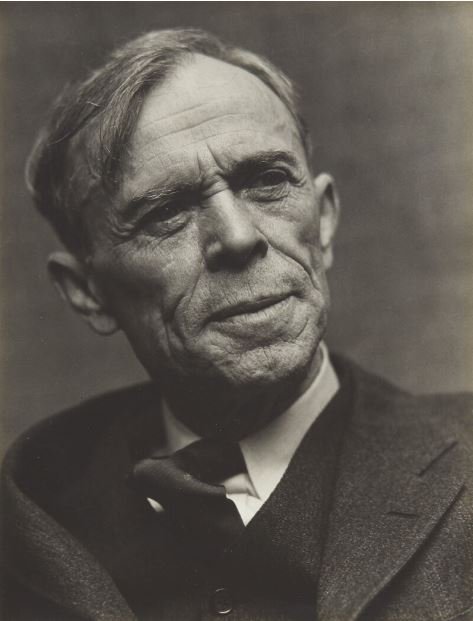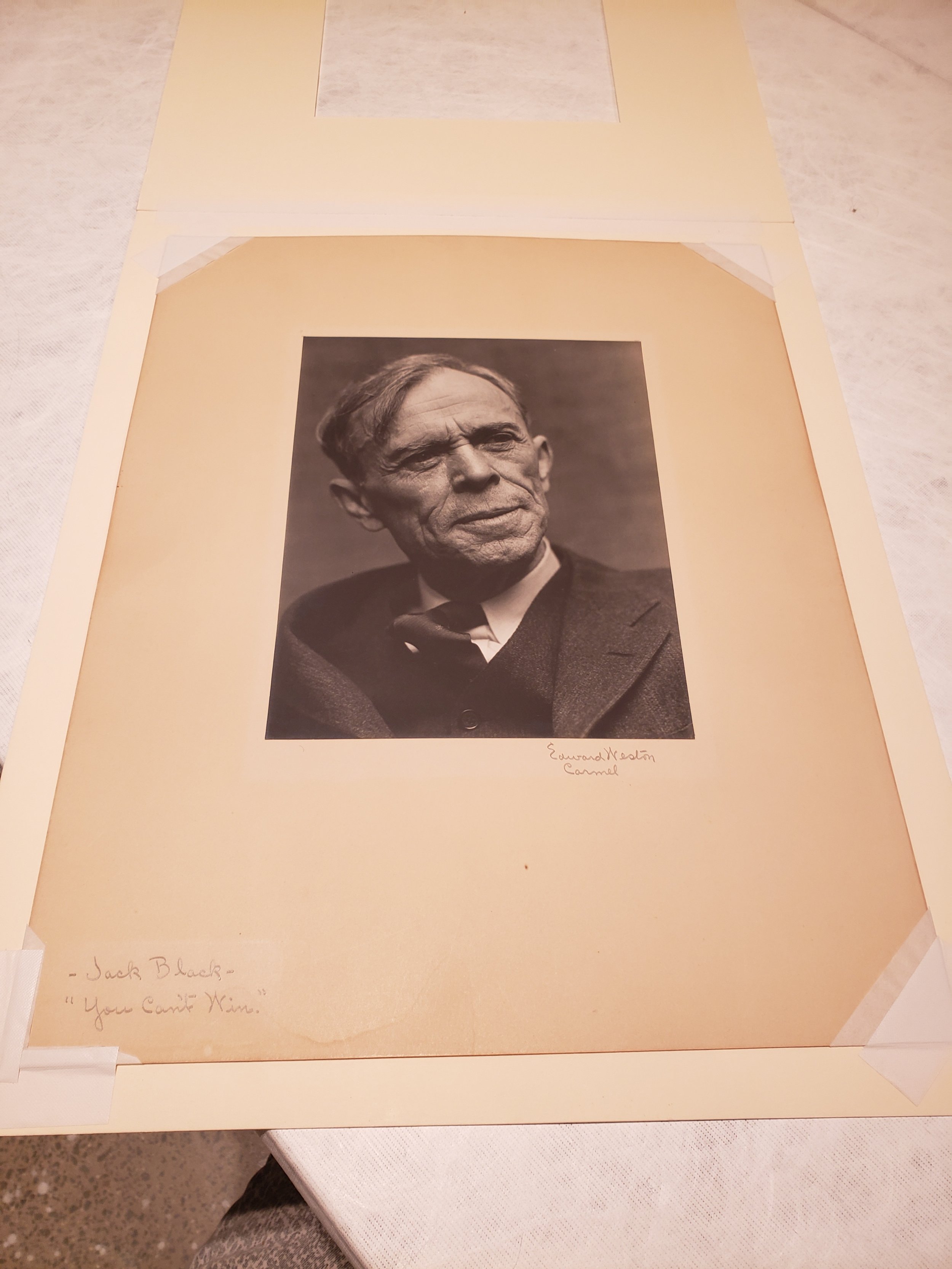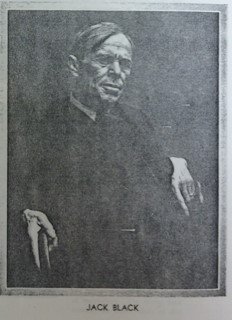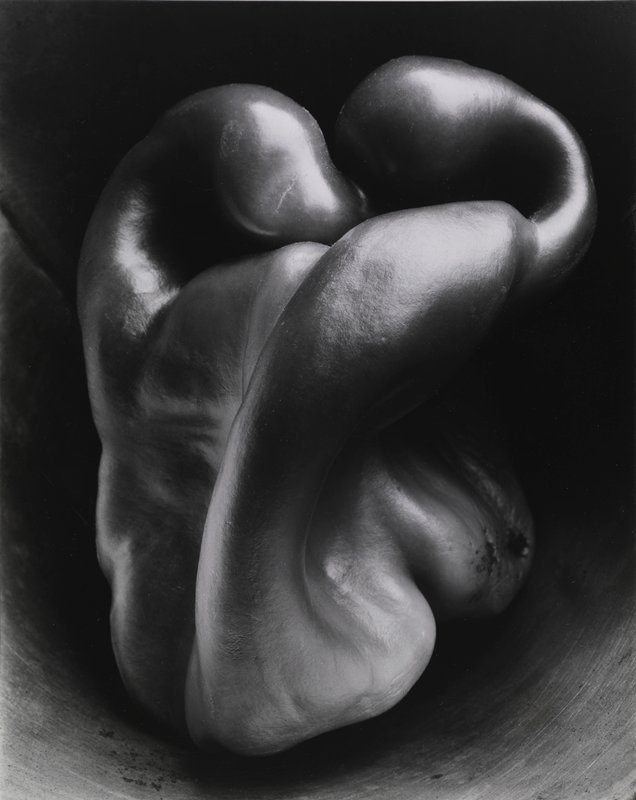Episode 17: Second Chances
In this episode I introduced you to the famous yegg, hobo, professional criminal, and writer, Jack Black.
His book, You Can’t Win was published in 1926. It made him a bit of a celebrity. The American public relished his juicy tales of fencing goods, doing opium, riding the rails, and landing himself in jail a time or two or three.
In 2020, Sotheby’s Photographs sold a portrait of Jack Black, taken in 1930 by Edward Weston. It shows Black looking aged from a hard life, but he smiles slightly, as if he’s just cracked a joke.
Jack Black by Edward Weston, gelatin silver print, mounted, signed, titled, dated, and annotated 'Carmel' in pencil on the mount, 1930, Sold at Sotheby’s New York, Photographs from the Ginny Williams Collection, 4 December 2020, $3,276. Here are some photographs I took while cataloguing.
“The right people are working on the wrong end of the problem. If they would give more attention to the high chair, they could soon put cobwebs on the electric chair. They lay too much stress on what the wrong people do, not on why they do it; on what they are, instead of how they got that way.”
Two other poses (that we know of) were taken by Weston during this portrait session.
Left image was illustrated in: Rodriguez, José. “The Art of Edward Weston: Edward Weston—Crazy About Photography As Was Hokusai About Drawing.” California Arts & Architecture 38:5 (November 1930): 36–38. [Illus. p. 36 as: Jack Black]
Right image was illustrated in: Armitage, Merle, ed. The Art of Edward Weston. New York: E. Weyhe, 1932. [Illus. Plate 18 as: Jack Black---Burglar, Author (Not in Conger).]
(Thanks to Paula Freedman for this information!!)
It seems that artist Joe Coleman was inspired by Weston’s straightforward photograph of Black as the basis for the illustration he created for the reissue of the book in 2015.
In this episode I also discuss photojournalism icon Lincoln Steffens, who was also photographed by Edward Weston in the early 1930s. The portrait below is in the National Gallery.
Another person discussed in this episode making waves in 1930 was Edward Weston. That year, Edward Weston took a series of still lifes of a some simple garden peppers. One of those images, of a pepper he placed inside a funnel, or Pepper Number 30, has become an icon of photography. The negatives from that summer would change the way he approached his work for the rest of his life.
Edward Weston, Pepper No. 30, 1930
Next up: The amazing Ginny Williams.
Sotheby's was honored to offer over 450 works from the celebrated collection of Ginny Williams across a series of sales throughout 2020. The photographs from Ginny’s collection included everything from Dorothea Lange to Sandy Skoglund! Ginny was quite simply a legend. Born in rural Virginia in 1927, Ginny moved to Denver, Colorado in the late 1950s with her husband, Carl Williams. An avid photographer herself, who studied with Austrian-American photojournalist and photographer Ernst Haas, her collecting journey began with classical figurative photography. Her passion and keen eye eventually prompted her to open her namesake gallery in Denver in the 1980s. While her passion for photography never waned, remaining a primary focus of both her gallery and private collection, her voracious curiosity quickly widened her curatorial focus. Over time, Ginny became increasingly courageous and experimental in her selections, venturing into Abstract Expressionism and Contemporary Art and following her artists themselves through gallery shows and museum exhibitions. As the years passed, Ginny became as much of a trailblazer as the artists she collected.
Ginny Williams
In closing, I’ll copy in full one of Jack Black’s article titled “What’s Wrong With the Right People.” It appeared in Harper's Monthly Magazine, June 1929.
The author of this article was for twenty-five years a criminal and served several prison terms; what he says about the criminal’s state of mind and the effect on him of society’s present method of combating crime is, therefore based upon direct personal knowledge.—The Editors.
“There’s a lot of law at the end of a rope.” That was the gospel of the California Vigilantes when they set out to clean up the crime wave of ‘Forty-nine. In the name of law and order they were going to take a short cut, kill a few killers and horse thieves, and make San Francisco safe for business. They were the “right” people of their time, noble gentlemen upon a noble mission bent; but like noble gentlemen turned reformers, all down the ages, they got drunk on blood-power. As long as they kept the rope for horse thieves the populace looked the other way, but when they succumbed to the inevitable temptation to hang business rivals and political enemies, this same populace made short shrift of them.
That was a world of ox carts and covered wagons. Ours is a world of automobiles and airplanes. Most things have moved along, but eighty years has made little difference in the methods with which the right people deal with the “wrong” ones. In the main they are facing the crime wave of 1929 with the mental attitude of the Vigilante.
“There’s enough law at the end of a night-stick.” This has the Vigilante ring to it, but it was spoken by New York’s most recent police commissioner at the outset of the clean-up campaign with which he began his regime. The only result apparent so far is a lot of indiscriminate clubbing and shooting by the police and a corresponding increase in murders and crimes of violence.
These are violent days. We are all agreed on that. The question is, who is responsible? Are the wrong people making the right people violent or are the right people making the wrong people violent? Or is it fifty-fifty?
From my seat on the side-lines it looks as though society were trying to out-gang the gangster, out-slug the slugger, and out-shoot the shooter, without pausing to ask whether it won’t result in simply pyramiding violence.
The right people all over America in press and pulpit are writing and preaching about the wrong ones. Crime commissions and individuals high and low, from the Chief Justice of the Supreme Court to the smallest small-town reformer, are surveying and recommending, and resolving and whereas-ing them. Legislators are legislating, and the police are pistoling and night-sticking. All are preaching and practicing more violence as a cure for crime.
Is there any justification anywhere, in any time, for believing this method will work? I don’t find it. I do not pose as an authority on crime and criminals. My testimony is that of a bystander — a guilty bystander, if you like, for I have survived four penitentiaries and numerous county jails….What happened to me as an individual is unimportant. I am useful only as an exhibit in the case; but if the laws which the right people are making to-day had been in effect fifteen years ago, I should never have had a chance to stop stealing and learn working. I should probably have been stopped by the rope, the chair, or a policeman’s bullet. Had I escaped these I should be a life-timer in some such prison as Dannemora or Charlestown, spitting my lungs out against a whitewashed wall and, like other life-timers, preaching to young offenders the doctrine of “shoot, and shoot first.”
Besides being wrong myself, I have known intimately, in and out of prison, almost five thousand wrong ones. This may seem a wide acquaintance, but in jail one has ample time for social intercourse. These five thousand constitute a cross-section of the underworld from which the crime wave bubbles up. They ranged from the petty thief who “snares” a door-mat with “Welcome” on it, to that prison patrician, the bank burglar. The door-mat thief was just as interesting to me as the bank burglar. It wasn’t what they did that interested me but why they did it. Some were mental cases, pathological, with bow-legged minds: in prison parlance, “a kink in the noodle.” Some were in prison because they had too little money and some because they had too much. Some because of ignorance and some because of over-education. Some were there because they were sent into overcrowded professions, when they should have had trades. Booze, “hop,” jealousy, avarice; all furnished their quota. A few appeared to be there from perversity — just downright cussedness.
The majority were guilty as charged, or of kindred offenses, though here and there one was innocent. Except for those convicted of crimes of passion, none had leaped into a criminal career overnight. Most had arrived by slow and gradual stages, the result of action and reaction. One was there because of a boyhood feud with the neighborhood cop. One because he lost his job in a strike. One because his wife got sick and his children were hungry.
We’ll assume that most of them were the initial offenders. They wronged society, and society, not understanding, wronged them back — with interest. The vicious circle that leads from one penitentiary to another had begun. All their stories could be hooked together on one thread: hatred of the police, contempt of the law, and fear and mistrust of the whole legal machine.
ii
My own case is typical. Up to the age of fifteen I thought a policeman was a hero, a person to be looked up to and trusted and confided in. Then one evening I was mistakenly “picked up, taken down, and thrown in” by one of them. The treatment I got in the jail from him and his brother officers shot that illusion all to pieces.
Every subsequent contact for twenty-five years strengthened those impressions, and it has taken me the best part of a lifetime to learn that the cop is a victim of the same machine which makes the criminal.
I got my first lesson in violence that first night in the jail. For twenty-five years I punished and was punished. I hunted because I was hunted. I showed no consideration for anybody because I expected to receive none. I learned the game of violence thoroughly, from the police, the courts, the prisons. In the end I came to believe that I could survive only by using violence-and using it first.
I know hundreds of reformed criminals and I don’t know one who was reformed by a policeman’s night-stick, a severe sentence, or prison cruelty. A brutal flogging in a Canadian prison, and, years after, three days in the murderous strait-jacket on a dungeon floor in California, certainly did nothing to turn my thoughts toward reformation.
The strait-jacket was to the prison warden what his rope was to the Vigilante, what the New York Commissioner would make of the night-stick — a short cut. The jacket had a brief reign and a swift and violent end. So far as I know, every man who was subjected to its ferocious punishment was so hopelessly maimed that he was a derelict for life, or so twisted mentally that he became a homicidal maniac. They left the prison like the little Jewish tailor whose hands were too shriveled to do any honest thing except to catch pennies on the street corner, or like me, poisonous and revengeful. This attempt to maintain order by “throwing the fear of God into them” failed as all such systems fail. It culminated in the bloodiest prison break in the history of the United States. Of the twelve men who escaped, six of the most desperate are still at large, with ropes around their necks, and the murders they have committed to keep out of the hangman’s grasp are almost unbelievable.
When I left prison, still weak from the effects of the strait-jacket, I swore to myself that from that time on I would be a creature of the night. I vowed I’d never let the sun shine on me, never make another friend or do another kindly act. The prison officials were safe in their prison, and I turned on society for my revenge. Within three months I was back in jail charged with robbery and shooting a citizen who refused to be “stuck up.” If he hadn’t had a good doctor and a good constitution, I shouldn’t have lived to discover that the pen is mightier than the jimmy or the six-shooter. If the Baumes Law had been in effect, I should never have discovered it, for that law robs the judge of all discretion. On the fourth conviction it is mandatory upon the judge to sentence a defendant to life imprisonment, whether he shoots a citizen or steals a pair of shoes.
For the past fifteen years I have been feeding and clothing myself instead of letting the tax-payers do it, because, at the time of my life when I least deserved it, I met trust and judicial leniency, which gave me hope. The judge who sentenced me to a year when he might have locked me up for life and thrown the key away, took a greater chance on me than I ever took on anything. He stopped my stealing as effectively as a hangman’s rope. He gave me my life and I couldn’t doublecross him any more than I could doublecross the friend who once cut the bars in a jail window and gave me my liberty. Loyalty is the only virtue of the underworld, and the judge appealed to that. He put me in a hole where I had to stop stealing and fall into the lock-step of society.
I repeat that I have never known one criminal who was reformed through cruelty. Such reformation as I have achieved is due, initially, to the act of the judge who said, when he sentenced me to a year instead of to life:
“I believe you have sufficient character to build a new life. I will give you that chance.”
iii
The records are full of the cases of men, notorious for their violence, who reformed when their loyalty was challenged. It’s the petty criminal, the weak man, without character enough to be very good or very bad, who violates parole, or any sort of confidence. He doublecrosses his fellow crooks and he doublecrosses society. The “worst” man is often the best bet. Frank James, train-robber and killer, threw away his guns when the governor of Missouri pardoned him. Al Jennings now pushes a pen instead of a six-shooter, thanks to Roosevelt’s pardon. Emmett Dalton, Chris Evans, Jack Brady, Kid Thompson — all highwaymen and killers — lived out the letter and spirit of their paroles.
“Desperate men bereft of hope are potentially violent men. ”
Desperate men bereft of hope are potentially violent men. The Baumes and kindred laws which destroy hope are violent laws, and they breed violence. At best they amount to nothing more than a policeman’s order to “move on.” At the worst they create a blind alley from which the only exit the desperate criminal knows is “Drop him before he drops you.” The result — a dead policeman here, a dead citizen there, a dead stool pigeen somewhere else.
Wrong ones and right ones are much alike when their backs are to the wall. They are both apt to get panicky and spoil what might be a polished, professional piece of work. A pickpocket with his hooks on a thousand-dollar poke may fumble it. There’s too much at stake. The crime-doctors, faced with an appalling increase of crime, are crowded into hasty action by a lot of nervous citizens who want the crime-wave stopped overnight. They recommend more laws, when they already have more than they can enforce. They recommend more punishment, when the experience of all the ages has shown its futility. They listen to the hue and cry against “mollycoddling” criminals, and restrict parole, probation, and pardon — the only measures that permit a criminal to reform. To lighten a leaky boat they throw overboard the biscuits and water.
Governor Clifford Walker of Georgia lifts a calm voice in the clamor for revenge: “The extreme crime-wave reformer,” says the Governor, “would abolish parole, probation, and indeterminate sentence, increase the severity and length of punishment, and frighten human nature into submission….Crime cannot be prevented by fear of punishment, or by harsh, cruel, or inhuman treatment. Such methods have been given a fair trial. There is no crosscut to the transformation of the delinquent.”
The federal probation officer of Pittsburgh, reporting to the National Probation Association, quotes some telling figures. He says that probation work on 106 offenders cost $1,097. The same offenders, had they been sent to prisons or reformatories, would have cost $26,452. Probation work, then, brought about a net saving of $25,355 to the government.
If from eighty to ninety per cent of the prisoners respect parole and probation, as the statistics show, it is a paying proposition, and any attempt of the right people to abolish or diminish it is bad business. If parole and probation were abolished entirely, probably seventy-five per cent of the prisoners would serve their sentences and come out of prison to return to their criminal careers.
Too much of the attention of the right people is focused on the habitual criminal. If every habitual criminal, in and out of prison, were poisoned or pardoned tomorrow at sunrise, we should still have a crime-wave, because the right people’s system of dealing with young offenders is guaranteed to grind out professionals.
“Society should pay more attention to the reform school than to the penitentiary. The character of the policeman who gets the boy first is more important than the judgment of the judge who gets him last. By the time the young offender faces a judge of the criminal court he is a finished product. Society’s best chance to turn him away from crime is before he has hardened into a professional. Therefore, the juvenile court is more important than the higher courts, and more common sense in the police courts would mean less congestion in the court of criminal appeals.”
iv
Recently a country boy appeared in the dock of a New York police court charged with vagrancy. He told the judge that he had a job and asked to be released. The judge was doubtful.
“When did you get the job? Since you’ve been arrested?”
“Yes,” the boy replied. “The policeman who arrested me got it for me last night.”
The judge complimented the policeman at great length; a reporter present saw a “story” in what had happened, and his editor printed it — because it was news. What would happen if it weren’t news, if all policemen acted that way? In Los Angeles a rosy-cheeked, redheaded, boyish young person of seventeen was picked up by a policeman for annoying girls on the street. At the station it was discovered that the young person was a girl in boy’s clothes. Police and press jumped to the first obvious conclusion, that she was a very abnormal person, and treated her as such.
But the juvenile court of Los Angeles, where Dr. Miriam Van Waters, the psychologist, is referee, is a very intelligent institution. There it developed that instead of being abnormal, the girl was extremely normal. She was a masculine type; she played boys’ games and lived the boy’s life. When she arrived at the stage where she wanted the normal girl’s share of masculine attention, wanted to be a sweetheart instead of a playmate, she found she had none of the wiles of her sex. She was torn between fear of being unable to attract boys and fear of not knowing how to act if she should attract one. She had no girl friends to advise her, so she put on boys’ clothes and went out to flirt with girls to find out how they behaved with boys. Her approach must have been clumsy or she would not have been arrested. If the approach of the juvenile court had been equally clumsy she would have gone into an institution — en route to heaven knows what. Instead, she got some sound feminine advice about clothes and conduct to restore her ego and give her confidence in herself.
If more of these bent twigs were approached in this scientific attitude, wouldn’t there be less dead wood lying around the prisons? Wouldn’t there be more respect for law and law-enforcers? Disrespect for the law in this country is not confined to the criminal, either juvenile or habitual; and the best minds in the country are trying to explain it. Is it, perhaps, because the law does not respect the people?
In England crime is less of a problem. The fact that with a homogeneous people there is no racial friction only partly accounts for the small percentage of criminals. The principal reason is that the Englishman respects the law because the law respects him.
Only recently England has been aroused from end to end over the arrest of a girl in a London park, without sufficient evidence of misconduct. Englishmen rose up from their breakfast tables when they read what had happened, and cried out, “That might have been my daughter. It’s outrageous.” They wrote letters to the Times about it; and the police of England are pretty responsive to such protests.
All crooks are equal under the law in England. The offender is not slobbered over by a lot of sentimentalists but neither is he clubbed into a “confession” by the police. There police protection means protection of the Englishman. What is “police protection” coming to mean here?
The police–crook alliance in this country discourages decent people and develops all the latent larceny in the rest of us. Those on the borderline of criminality are encouraged to take a chance; they make a plunge for easy money in the hope of becoming one of the many favored and protected aristocrats of the underworld; and the high-school boy, reading newspaper reports of the gangster’s heroic death and magnificent funeral, forgets his Lindbergh and says to himself, “Not so bad.”
The right people are all for bigger police forces. The crime commission’s reports bristle with phrases like “lengthening the arm of the law” and “strengthening the police arm.” I will go them one better. I am for bigger and better police forces. A bigger police force with the same system would only multiply the evils which the right people are trying to correct.
The case of X is an instance of the sort of police work which is guaranteed to fix in the mind of an individual a lasting hatred of the police. X was a young girl of a type common on the fringes of the underworld. She was attractive, soft, and used to the luxurious living provided by patrons of the night-clubs. Her lover was in jail charged with a series of robberies. The case against him was weak. The girl was arrested on the theory that she might have information which would aid the police in convicting him. She denied all knowledge of the crime. The detective who made the arrest ordered her locked up and said to reporters in the press room, “Don’t worry. She’ll come through. I’ve got her locked in the dirtiest cell in the city prison. She won’t get a bath — she won’t wash her face for three days. She’ll get good and lousy, and then she’ll squawk.”
He was right, and the information he got sent the man she loved to prison. Already a social outcast, she went back to face the contempt of the underworld, too, for she had committed the only unpardonable crime. She lives in an atmosphere of hatred and scorn, shadowed by the fear that any night she may be “taken for a ride.”
The case of X is a straw in the wind and what happened to her and her lover is of little consequence. But the detective’s action is a perfect example of the sort of police work which breeds more crime. For while his ingenious plan brought about a quick conviction, it might well have caused the girl’s murder, and that murder, another hanging. Who can estimate the results of a lifetime of such detective work, where every act radiates hatred, fear, and mistrust?
By a better police force I mean a police force composed of men who have a less punitive and a more scientific attitude toward crime and criminals. Such men are not to be had for the wages paid by most municipalities. The Philadelphia police scandal shows that the men are paid salaries which are almost an invitation to graft. Suggest raising their salaries and the average voter would say, “They’re getting theirs now. They’re getting fat.” But what legitimate inducement is there for ambitious young men to go into the police department? Handicapped by poor pay, ridden by politicians, and surrounded by an atmosphere of graft, with little promotion except through favoritism, what chance is there for good men to do intelligent, humane, and constructive police work?
The same conditions exist in the prisons. The guards are scandalously underpaid, and most of them are broken down, rejected ward heelers. The captains and lieutenants are usually small politicians on the shelf, while the warden is too often a graduate of the guard-line. If by any chance a business man or a humanitarian is chosen as warden of one of our prisons, the politicians immediately sharpen their axes for him, and off goes his head with the first swing of the political pendulum. The fate of the late Thomas Mott Osborne who revolutionized Sing Sing and was put out by the politicians, a broken and discouraged man, proves this, as does the recent removal of Warden Smith of San Quentin, California.
August Vollmer, nationally known as a scientific chief of police, gets amazing results in his handling of criminals in Berkeley, California, where he is not hampered by politics. Called to Los Angeles to reorganize the police department, he lasted just one year. Hamstrung by politicians and doublecrossed by his subordinates, he gave it up as a job too big for anyone man. Vollmer wouldn’t “play along” with crooks-in-office, and it was not until he had shaken the dirt of Los Angeles County from his feet that the district attorney who balked him at every turn was convicted of taking bribes and sentenced to San Quentin.
v
The problem seems too big for any one crime commission, or any number of crime commissions for that matter. But if anyone thing seems certain, it is the folly of more laws and more punishment.
Lao Tse, who was a contemporary of Confucius, said, “Govern a kingdom as you would cook a small fish,” meaning do not overdo it. “The more active is legislation, the more do thieves and robbers increase.”
A great Chinese Emperor, founder of the Ming Dynasty in 1868, took his cue for abolishing the death penalty from this philosopher. “Almost every morning ten men were executed in public,” wrote the Emperor. “By the same evening a hundred had committed the same crime. Lao Tse said, ‘If the people do not fear death how then can you frighten them by death?’ I ceased to inflict capital punishment. I imprisoned the guilty and imposed fines. In less than a year my heart was comforted.”
England made the same discovery. They didn’t stop hanging people in England for sheep-stealing, shop-lifting, or pocket-picking because it stamped out those crimes. They stopped because of the alarming increase in the murder rate. The law made potential murderers out of petty thieves. The extreme penalty failed to stop pocket-picking even in the shadow of the gallows. Men were arrested for picking the pockets of a crowd assembled to witness the hanging of a pickpocket. Once the English hanged people for sixty different offenses. Now they are considering the abolition of the death penalty, even for the only remaining one. England has proved that violence doesn’t cure violence.
It is safe to say that if every voter in America could be forced to witness a hanging or an electrocution, capital punishment would be abolished at the next election. Certainly no one who has lived through one of those black Fridays in prison, could doubt that evil walks with the hangman. As the day of execution draws near the prison becomes a smoldering volcano. The convicts grow sullen and short-tempered. Old grudges are opened, old hates revived. Stool pigeons are stealthily slugged; guards are cursed, defied, and assaulted. The dungeons are filled with unruly prisoners “boiling up” with hatred. On those Fridays I have seen the most murderous knife-duels between prison enemies. In the stone quarries at Folsom men threw thousands of dollars’ worth of valuable steel tools in the canals and smashed with sledge hammers pieces of carved and polished granite upon which they had worked for months. In a blind, helpless surge of revolt they destroyed whatever they could get their hands on. In the “diner” I have seen hungry men hurl their food to the floor, refusing to eat “the damned hangman’s stew.” On this day of legal violence imprisoned men became so violent that the wardens finally hit upon the plan of keeping the “main line” locked up until after the execution. Now men sit in their cells brooding in silence, or make the prison corridors ring with their hoots and curses.
Of one thing the right people may be sure: no prisoner’s thoughts are turned toward anything of good on such a day.
vi
“What, in a nutshell, is my case against the right people? I contend that more laws and more punishment will mean nothing but more crime and more violence. ”
What we need is more science. We need more emphasis on prevention than on punishment. More attention should be paid to the juvenile from the broken home and from the overcrowded and unsanitary slums. Scientists, school teachers, and social workers who are trying conscientiously to fit the delinquent for the job of living, should be freed from interference by politicians and job-holders whose methods have already been tried and have failed. Perhaps there should be more vocational guidance directing the youth into undermanned trades instead of overcrowded professions.
Any intensive study of the population of any American prison will show that most of them are men who have not been trained for the job of living or making a living. During my time at San Quentin a notice was tacked on the bulletin board asking for ten accountants to apply at the Captain’s office to help on the annual reports. When the day came forty prisoners applied for the work, and all of them were qualified to do it. There were college men in San Quentin, lawyers, doctors, dentists, bookkeepers, accountants, mathematical experts, inventors, writers, lecturers, and one poet. Later in the winter when a brick factory chimney was damaged by storm, a bulletin was posted calling for bricklayers. None appeared, although the job carried privileges including “three squares a day” and possible parole if it were well done. A search of the register disclosed several “bricklayers,” but on inquiry it developed that they were just plain crooks who had “thought it looked better to give some kind of a trade.” The best the Captain could find was a man who had once served as bricklayer’s apprentice. It took him three months to mend the big chimney, and he ate his three meals a day in the guards’ quarters and got an immediate recommendation for parole.
Doesn’t that show that the skilled artisan is not the man who does the going to jail?
If the crime commissions would utilize the best laboratory material they have — the criminal — the reports they submit would be more valuable. Their conclusions and recommendations are the result of a long-distance, ex-parte diagnosis. It is as though a committee of doctors solemnly meeting in Boston or Washington were to diagnose the cases of ten thousand patients scattered all over the United States, without ever examining one of them. Imagine these same medical men solemnly writing one formula to cure them all. Yet ridiculous as this may seem, it is more reasonable than a blanket recommendation for the cure of crime, without examination, or autopsy, for the causes of crime are more varied than the causes of disease.
The secret of the cure of crime — if there is one — is contained in a knowledge of its causes. The psychologist, with his cool scientific mind and a background of knowledge secured through experiment and observation, is only just beginning to learn why we behave like human beings. How much more difficult is it to determine why so many of us behave inhumanly! Yet without so determining, who can prevent the crime wave of to-morrow which is in the kindergarten of to-day?
The right people are working on the wrong end of the problem. If they would give more attention to the high chair, they could soon put cobwebs on the electric chair. They lay too much stress on what the wrong people do, not on why they do it; on what they are, instead of how they got that way.
Danny Ryan’s mother said it all when she held out her arms to her son in the cell next to mine and cried:
“Danny, boy, how come you so?”
.
Further reading:
"Out of prison", San Francisco Bulletin, February/March 1917.
"The big break at Folsom", San Francisco Bulletin, January 1917.
Black, Jack "What's wrong with the right people?", Harper's Monthly Magazine, June 1929.
Black, Jack "A burglar looks at laws and codes", Harper's Monthly Magazine, February 1930.
"Jack Black's Tales of Jail Birds", New York World, December 21, 1930.
Jamboree, with Jack Black and Bessie Beatty; Elizabeth Miele, producer, 1932.











